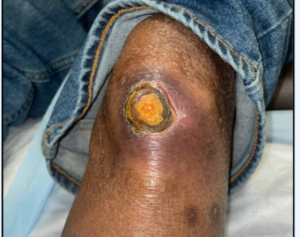Arterial ulcers of the lower extremity
History
The patient is a 63-year-old male with h/o significant arterial occlusive disease in both legs , with the left leg being more affected than the right. He underwent an aorto-bifemoral bypass graft in February 2023 for critical limb ischemia and multiple non healing ulcers both legs. He was referred by the vascular surgeon to our wound center for the management of arterial ulcers both legs in March 2023.
His past medical history includes prostate cancer, coronary artery disease s/p coronary angioplasty with stent placement, type 2 diabetes, hypercholesterolemia, hypertension, hypothyroidism, neuropathy and craniopharyngioma. He has a history of cigar smoking for ten years, having quit in 2020. He does not drink alcohol and there is no history of illegal drugs. Cardiac echo was normal with an ejection fraction of 55.
At time of initial presentation pertinent medications included insulin, 75 mg of clopidogrel, and 100 mg of cilostazol.
AT INITIAL PRESENTATION

Pic#1: Right lateral ankle ulcer at initial presentation March 2023

Pic#2: Left knee ulcer at initial presentation March 2023

Pic#3: Left Achilles ulcer at initial presentation March 2023

Pic#4: Left lateral malleolus ulcer at initial presentation March 2023

Pic#5: Right lateral ankle ulcer July 2023

Pic#6: Left knee ulcer July 2023

Pic#7: Left Achilles ulcer July 2023

Pic#8; Left lateral malleolus ulcer July 2023
Findings:
At his initial visit in March 2023, he had a right lateral ankle ulcer, left knee ulcer, left Achilles ulcer, and left lateral malleolus ulcer ( Pic #1-4).All ulcers were 100% yellow/black dry necrotic ulcer base, and skin on both legs had excessive dryness, particularly the left leg. There were areas on his left foot with dry scaly, peeling skin and dry hyperkeratotic thick plaques. His mobility was poor and he needed a wheelchair or walker. After his aorto-bifemoral bypass graft he reported that pain in his legs was much improved.
Between March 2023 to July 2023, the ulcer on his left knee became larger and deeper with tendon exposed. The ulcer on his left Achilles had necrotic Achilles tendon exposed, and the left lateral malleolus ulcer had more necrosis. The right lateral ankle ulcer was stable (pic#5-8). The pain in ulcers returned especially in the left knee and left Achilles ulcer. The skin on legs and left foot had improved and was less dry. All ulcers remained without infection.
Diagnosis:
The Arterial ulcers of the legs were diagnosed based on history with history of atherosclerotic disease, the appearance of the ulcers; deep with exposed deeper structures, well demarcated, with little or no drainage and painful. Vascular diagnostic studies included ABI/PVR, angiography or CT angiography.
The patient underwent CT angiography in January 2023 that showed extensive arterial occlusive disease with occlusion of right common iliac, external iliac and left common iliac, near complete occlusion in right and left superficial femoral arteries and multifocal disease in the other major arteries of both limbs
Differential Diagnoses:
Workup Required:
Plan:
Overall plan was multidisciplinary including vascular intervention/surgery to restore circulation in limb ischemia, regular wound care under the direction of a wound physician, skilled nursing for wound care, physical therapy for strengthening, pain management, podiatric foot care, offloading foot wear, referral to other specialists as needed.
Expertise Needed:
Treatment:
Treatment has been multidisciplinary
First, the patient had arterial reconstruction to maximize arterial blood flow to the lower extremities.
From the initial presentation in March 2023 to July 2023, the patient had regular wound center visits every two weeks. He also had visiting home nurses providing skilled wound care 3x/week following orders of the wound physician.
Treatment in the wound center included washing the legs and feet without dressings with soap and water and cleaning the ulcers with antibacterial cleaning solutions like Hibiclens. Skin care included moisturizing intact skin on legs and feet with Aquaphor. Ulcer dressing consisted of applying cadexomer iodine paste to the ulcers covered with alginate, foam, and a lightly wrapped conforming gauze wrap to keep the dressings in place. Occasional gentle debridement of the ulcers in the wound center was done to remove obvious necrotic tissue. The debridement with sharp instrument was very painful for the patient despite local anesthesia. Care needs to be taken with debridement in arterial ulcers as debridement may lead to further necrosis because of the reduced perfusion to the ulcers
The ulcers had minimal drainage and the goal of the dressing was to provide antimicrobial action, comfort, and protection. He was given med-surg shoes to wear on both feet so there is no friction or pressure on ulcers. In bed, he wore padded protective boots on both feet and ankles. The patient was encouraged to wear loose warm socks and long loose pants to keep the skin temperature warm
Although the ulcers remained without infection they failed to show healing and started to get larger and deeper on the left leg with tendons getting exposed in the left knee ulcer and left Achilles ulcer. The right ankle ulcer remained stable. (pic # 5-8). He also started complaining about increased pain in left leg ulcers, especially the left ankle and Achilles ulcer. He was sent back to the vascular surgeon for a consult. An angiogram performed by the vascular surgeon revealed an occlusion in the left distal SFA into the popliteal artery. In July 2023 he underwent a left femoral to below knee popliteal bypass with in situ saphenous vein. He was sent to a skilled nursing facility after this surgery. Three weeks later he developed surgical site dehiscence with infection. The vascular surgeon did another surgical procedure which included incision and drainage of hematoma and debridement and exploration of bypass graft. During this surgical procedure, the surgeon also did excisional debridement of subcutaneous tissue and tendon in the chronic ulcers left knee, left lateral malleolus, and left Achilles area.
After a few weeks in a skilled nursing facility, he returned home and resumed wound care in the wound center every 2-4 weeks with three times a week wound care provided by home visiting nurses. The wound care remained the same except occasionally if the ulcers became too dry the topical was changed from cadexomer iodine to Manuka honey.
Now that the blood flow had been restored to the left leg and the ulcers had been surgically debrided the ulcers started to respond and showed signs of progressive healing
The following multidisciplinary care plan was continued along with wound care

Right lateral ankle ulcer healed October 2023

Left knee ulcer healed in October 2024

Left lateral malleolus ulcer healed in October 2024

Left Achilles ulcer December 2024
Follow Up:

